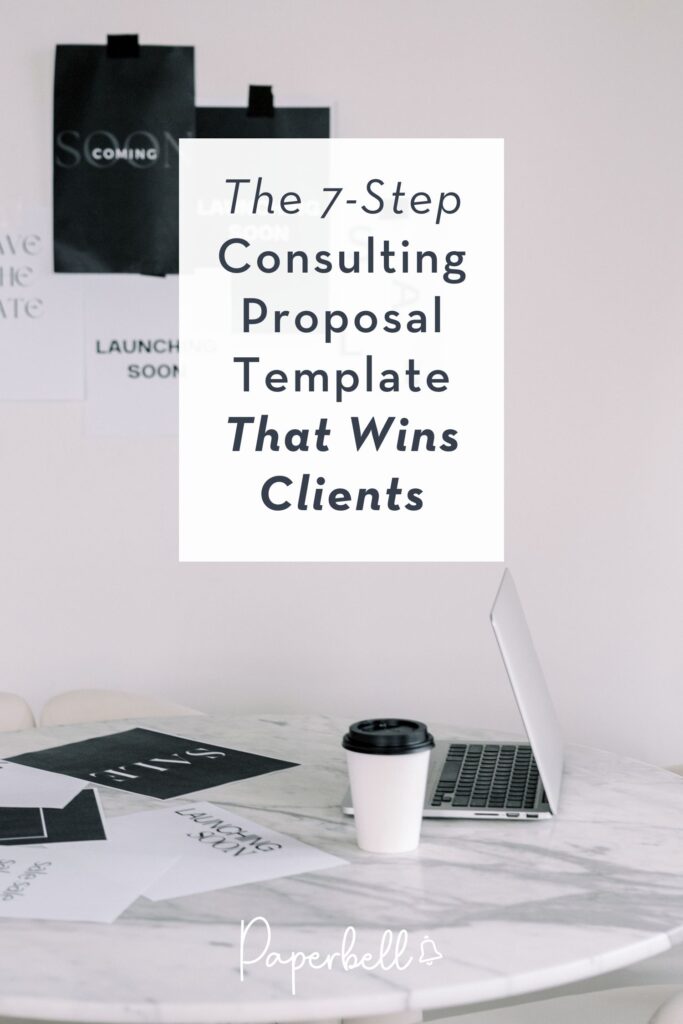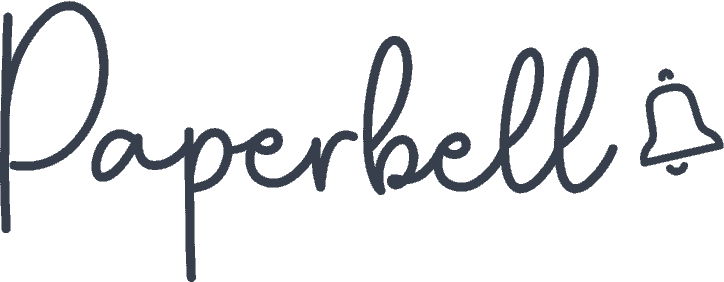A consulting proposal is more than just a formality. It’s your chance to make a strong first impression and win new business.
In this guide, we’ll break down the essential elements of an effective consulting proposal, a few free templates, and what makes them convert.
What Is a Consulting Proposal?
A consulting proposal is a formal document that outlines the services you’ll provide to a prospective client, including the scope of work, timeline, deliverables, and pricing.
It’s how you introduce yourself, define your value, and lay the groundwork for a successful client relationship. A strong proposal doesn’t just list consulting services; it demonstrates your expertise, aligns with the client’s needs, and makes it easy for them to say, “Yes, let’s do this!”
A consulting proposal outlines the following:
- The client’s challenge or opportunity (what they need help with)
- Your proposed solution (how you’ll tackle it)
- The scope of work (what’s included and what’s not)
- Timeline and deliverables (when they can expect results)
- Pricing and payment terms (how much it costs and how you’ll get paid)
Some consultants treat proposals like a generic template, swapping out a few details and sending them off. However, the most effective consulting proposals are personalized, persuasive, and clear about the value you bring to the table.
7 Essential Elements of Winning Consulting Proposals
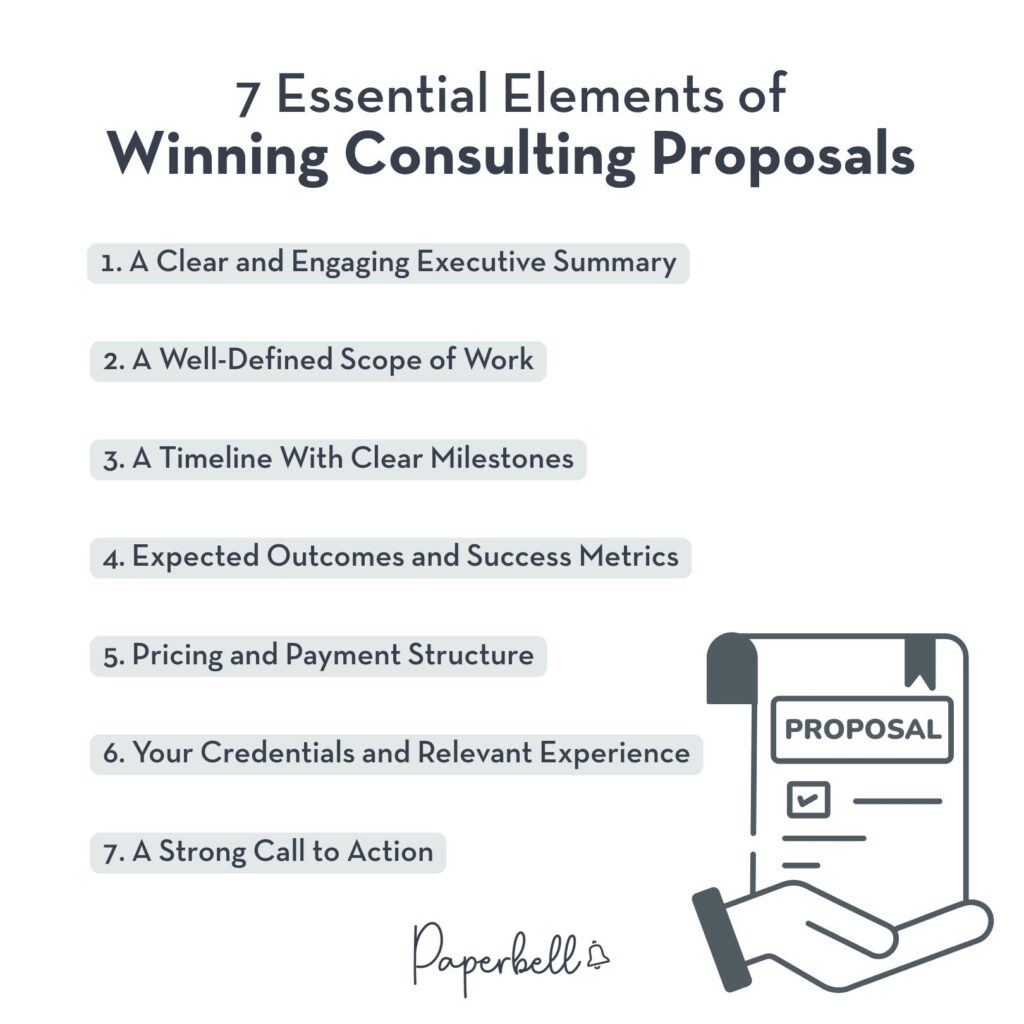
A strong consulting proposal is your opportunity to showcase your expertise, set expectations, and close the deal. To make sure your proposal is effective, here are the key elements you need to include:
1. A Clear and Engaging Executive Summary
Your executive summary is the first thing your client will read, so it needs to grab their attention and immediately communicate why they should keep reading. This section should:
- Acknowledge the client’s needs: Show that you understand their problem or goal.
- Briefly introduce your solution: Give a high-level overview of how you can help.
- Highlight the outcome: Your project summary should clarify what success will look like if they work with you.
Example: Your company is struggling with high employee turnover, leading to increased hiring costs and lower productivity. I propose a targeted retention strategy that includes leadership training and a revamped onboarding process. Within six months, you can expect to see a 20-30% improvement in retention rates.
2. A Well-Defined Scope of Work
This section lays out exactly what you’ll be doing, and just as importantly, what you won’t be doing. The goal is to prevent misunderstandings and scope creep down the road.
To define your scope effectively:
- Break down your process: List the key tasks or phases of the consulting project.
- Clarify what’s included: Be specific about deliverables (e.g., “Three 90-minute strategy sessions” rather than just “strategy support”).
- Set boundaries: If something isn’t included (like ongoing maintenance or additional revisions), state that upfront.
Example: This proposal covers a full SEO audit and strategy development, including keyword research, competitor analysis, and on-page optimization recommendations. It does not include the implementation of technical fixes or ongoing SEO monitoring.
3. A Timeline With Clear Milestones
Clients want to know when they can expect progress, so a timeline helps set realistic expectations.
To create a strong timeline:
- Break the project into phases: If your work happens in stages, outline them clearly.
- Include estimated timeframes: Specify deadlines for key deliverables.
- Stay realistic: Don’t overpromise! Give yourself buffer time for unexpected delays.
Example:
- Week 1-2: Initial consultation and discovery phase
- Week 3-4: Research and strategy development
- Week 5: Presentation of strategy and feedback session
- Week 6-8: Implementation support and final adjustments
4. Expected Outcomes and Success Metrics
Clients don’t just want to know what you’ll do; they want to know how it will benefit them. This section should answer the following:
- What results can the client expect?
- How will success be measured?
If possible, use data or case studies to back up your claims. If the results depend on client implementation, clarify their role in achieving them.
Example: By optimizing your onboarding process, we aim to reduce employee turnover by at least 20% within the next six months. Success will be measured by comparing pre- and post-implementation retention rates.
5. Pricing and Payment Structure
Transparency in pricing builds trust and prevents awkward money conversations later. Your pricing section should:
- Break down costs clearly: Avoid vague pricing and be upfront about what’s included.
- Offer package options (if applicable): This gives potential clients flexibility while anchoring them to your higher-value offering.
- Clarify payment terms: State when and how payments are expected (e.g., upfront, 50/50, milestone-based).
Example:
- Option 1: Full Strategy Package at $5,000. Includes a full audit, strategy development, and three implementation check-ins.
- Option 2: Strategy Only at $3,000. Includes an audit and strategy development, but no implementation support.
- Payment Terms: 50% due upfront, 50% upon project completion.
6. Your Credentials and Relevant Experience
Even if a potential client is already familiar with you, this section reinforces why you’re the right person for the job.
- Highlight relevant experience: Mention similar consulting projects you worked on in the past.
- Include client testimonials or case studies: Real-world results help build confidence.
- Keep it concise: You don’t need a full resume—just the highlights that matter most.
Example: I’ve worked with companies like [Client A] and [Client B] to improve their employee retention, leading to a 25% decrease in turnover within a year. Here’s what one client had to say: ‘[Testimonial].’
7. A Strong Call to Action
A consulting proposal without a clear next step can leave a potential client unsure of how to move forward. End with a clear, action-oriented closing that makes it easy for them to say yes.
Example: I’d love to discuss this proposal with you and answer any questions. If everything looks good, we can move forward by signing the agreement and scheduling our kickoff meeting. Let me know how you’d like to proceed!
How to Write a Consulting Proposal That Converts
Here’s what you need to remember when writing a business consulting proposal to make saying yes a no-brainer for clients.
Step 1: Research the Client’s Needs
Before you write a single word, take the time to understand exactly what the client is struggling with.
- Review any past conversations, emails, or notes from discovery calls.
- Research their business, industry, and competitors.
- Identify the key pain points they need help with.
For example, if a company is experiencing low employee engagement, dig into potential causes like unclear leadership, lack of professional development, or a weak company culture.
Step 2: Start With a Client-Focused Opening
Your proposal should begin with a project overview that makes the client feel heard and understood. Avoid starting with a generic introduction about yourself. Instead, focus on them.
- Clearly state the client’s problem in their own words.
- Show that you understand their goals and challenges.
- Set the stage for your solution.
Here’s an example: “You mentioned that your sales team is struggling with inconsistent lead conversion, which is affecting revenue growth. Without a clear sales process, it’s difficult to scale effectively. My role is to help you streamline this process so your team can close more deals with confidence.”
Step 3: Present a Tailored Solution (Not Just Services)
Instead of listing your consulting services like a menu, explain how your approach directly solves their problem.
- Describe the specific strategy or methodology you’ll use.
- Connect each part of your solution to the client’s needs.
- Avoid technical jargon and, instead, keep it clear and relatable.
Example: To improve conversion rates, I’ll implement a structured sales training program tailored to your team’s challenges. This includes:
- Analyzing past sales calls to identify improvement areas
- Creating a customized script and objection-handling framework
- Training sessions to help your team confidently apply new techniques
Step 4: Make the Proposal Visually Scannable
Most clients will skim before they read. A long wall of text? That’s a quick way to lose their attention. Instead, make sure you:
- Use bullet points and short paragraphs.
- Bold key takeaways so they stand out.
- Add simple graphics or tables for clarity if needed.
Instead of writing a long paragraph about your process, you may break it into something like this:
- Phase 1: Discovery and Research—Assessing current sales calls and identifying improvement areas.
- Phase 2: Training and Strategy Development—Developing custom training material and conducting workshops.
- Phase 3: Implementation and Feedback—Observing live calls, providing feedback, and refining strategies.
Step 5: Provide Clear Pricing with Context
Instead of just listing a number, explain the value behind it. When clients see the impact of your work, they’ll be more willing to invest.
- Break down the pricing structure (e.g., by phase or package).
- Show what’s included to justify the cost.
- Offer options if it makes sense for flexibility.
Example:
- Option 1: Full Sales Training Program at $7,500. Includes all workshops, scripts, and post-training support.
- Option 2: Basic Training at $4,500. Covers workshops and scripts but excludes ongoing coaching.
You may add, “This investment will not only help increase conversion rates but also provide your team with a repeatable framework to close more deals long-term.”
Step 6: End with a Clear Call to Action
Let the client know what to do next.
- Tell them how to move forward (e.g., sign your contract or clarify some missing details).
- Set a deadline if applicable to create urgency.
- Make it easy by including a single link for your complete onboarding flow (more on this in a bit).
For example, you may share the link to your Paperbell page, saying:
“If you’re ready to get started, you can review and sign the contract, settle the advance payment, and book our first session here.
If you have any questions before moving forward, feel free to reach out. I’m happy to clarify anything to ensure this is the right fit for you!”
Bonus Tip: Keep It Conversational Yet Professional
A proposal doesn’t have to feel like a dry legal document. Keep the tone engaging and easy to read while maintaining professionalism and keeping it focused.
If it feels like a one-sided contract, the client might hesitate. If it feels like a helpful plan to solve their problem, they’ll be excited to work with you.
Doing this will make your consulting proposal look great and get it approved faster.
Ready to start crafting your proposal for your next big client? Download this template and simply fill in the blanks. Feel free to customize it as you see fit.
3 Free Consulting Proposal Templates You Can Customize
Real-world project proposals can provide valuable insights into how to draft yours. Others give you a great starting point for designing your document. Here are three winning consulting proposal templates and what you might implement from them.
1. Sample Proposals by Alan Weiss
Alan Weiss, a renowned consultant, offers a collection of sample business consulting proposals that range from formal contracts to informal agreements.
This compilation of proposal formats showcases various styles you can adopt for different client needs and project scopes. Each proposal includes essential components such as situation appraisal, objectives, methodology, and fees.
Note that this template was published in the 2000s, so while its core guidelines still stand, the content and language may not reflect current industry practices. It also lacks visual elements that would make it more compelling and easier to digest, though you can easily fix that with one of Canva’s templates.
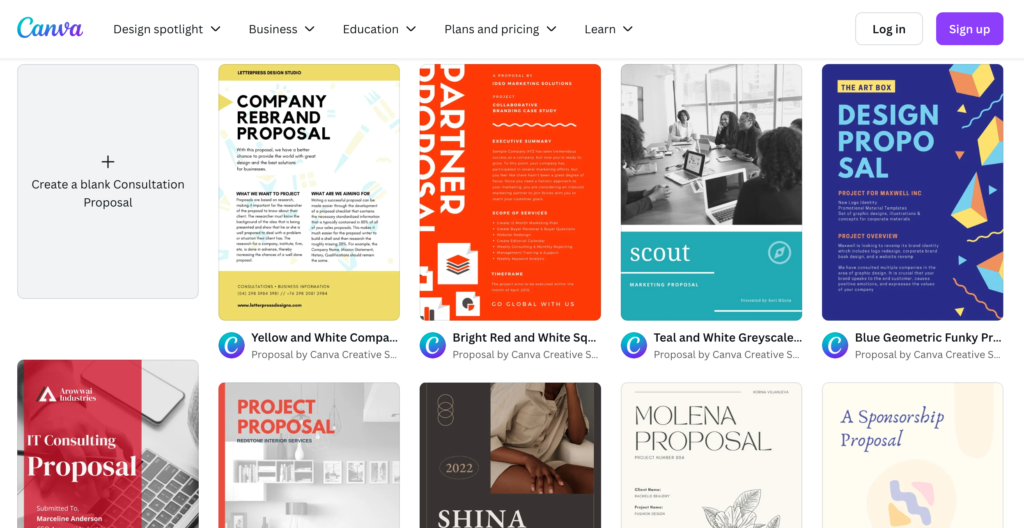
2. McKinsey Consulting Proposal
McKinsey, a leading management consulting firm, also has project proposals available publicly, like this one. This 36-page proposal was submitted in 2023 to the Department of Treasury in New Jersey and helped McKinsey land the $3,994,610 project.
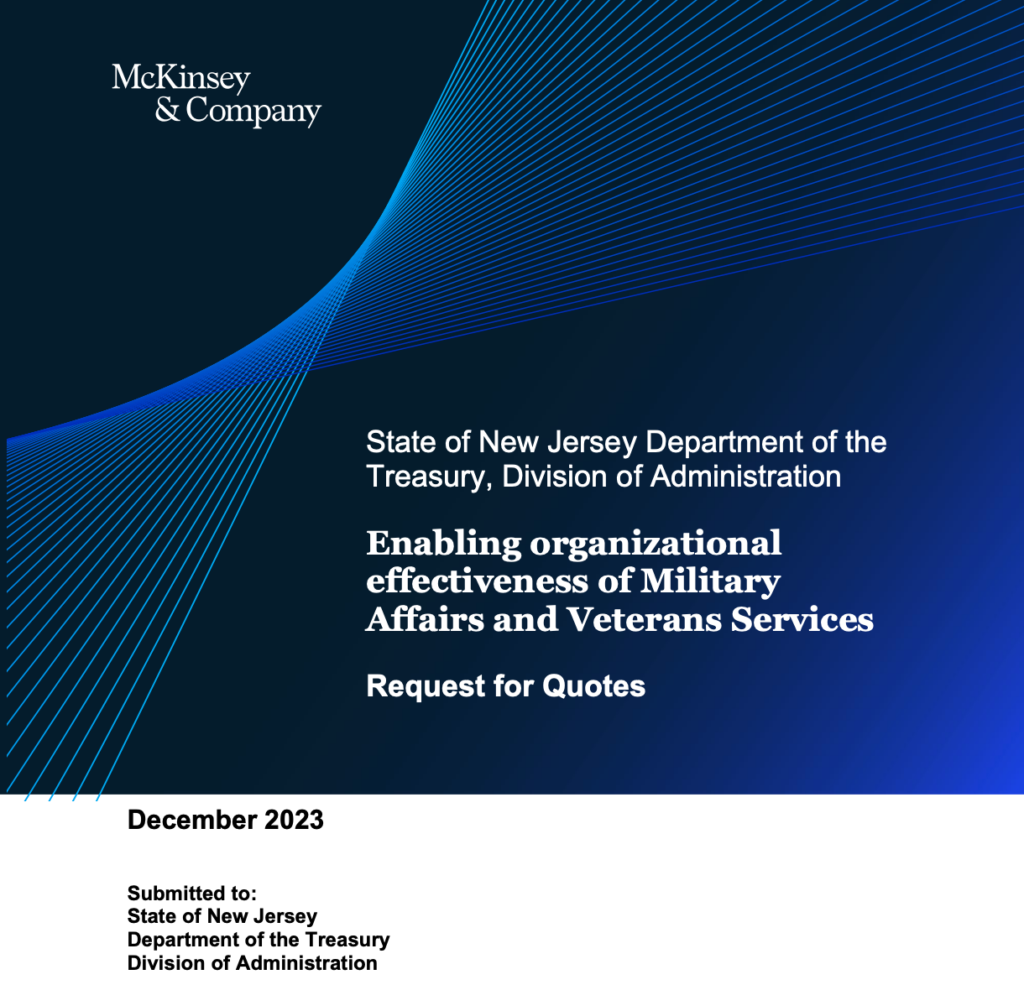
It clearly outlines the client’s current situation, challenges, and proposed solutions. McKinsey’s proposals are rich in data and analysis, demonstrating a deep understanding of the client’s industry and specific issues.
Being a high-level governmental project, the language of this proposal is quite complex. It’s stuffed with jargon that may not appeal to clients who need easily digestible summaries. If you want to dig deeper, here are a few other proposals from major consulting firms.
3. Consulting Proposal Templates by Venngage
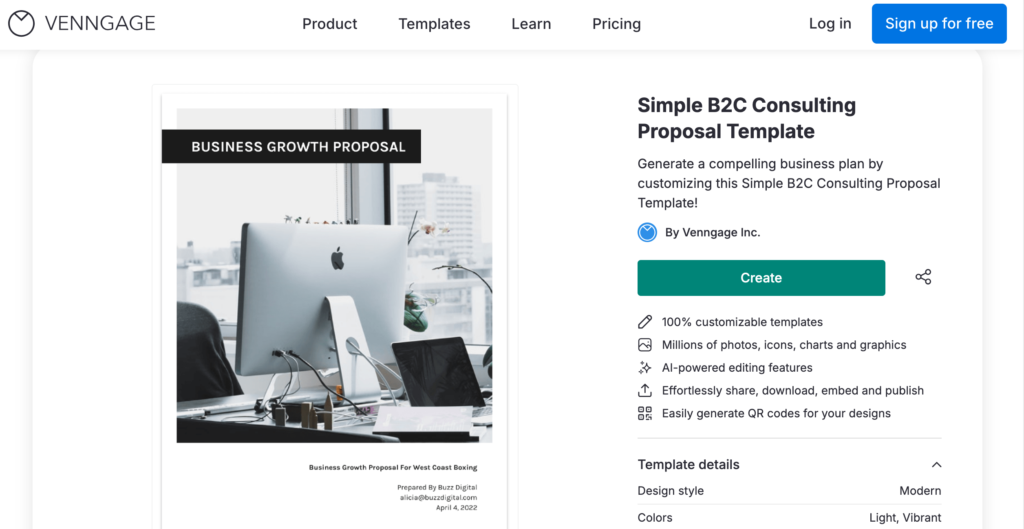
Venngage has a variety of visually appealing templates for consultants. They incorporate modern design elements and are easy to navigate. You can customize them with your brand elements and proposal structure.
Although these proposal design templates look great, there isn’t as much you can draw from their content compared to real-world examples.
Streamline Your Consulting Business with Paperbell
Instead of drafting lengthy proposals, what if you could send clients a single link where they can review your offer, sign the contract, make their payment, and book their first session—all in one place? That’s exactly what Paperbell allows you to do.
Rather than sending a PDF, you can create a landing page in Paperbell that lays out all the key details of your offer.
If you’d rather customize your proposals for each client, you can share them with your clients and provide a single link as a clear next step for them to accept your offer and get on board.
This way, once the client reviews your proposal, they can immediately take action, signing the contract, paying, and booking on your site.
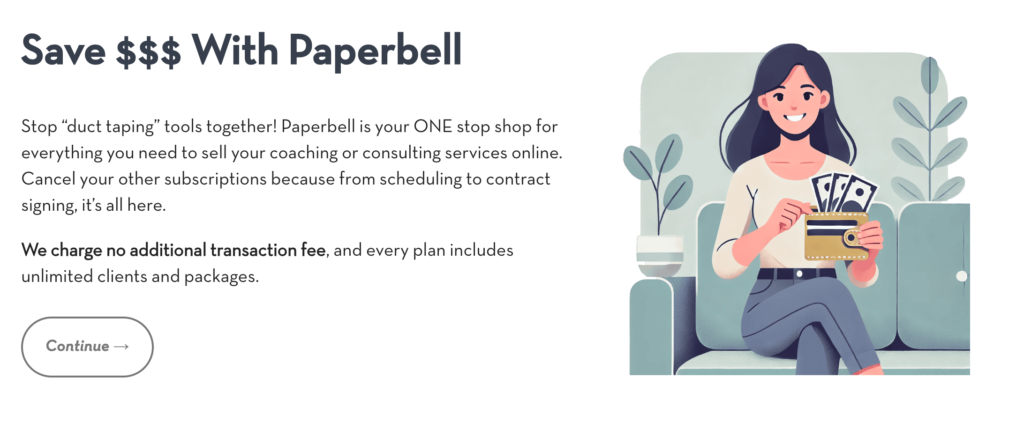
Beyond simplifying client onboarding, Paperbell also handles your coaching website, client surveys and notes, automated emails, and all other aspects of your client management workflow.
It’s an all-in-one tool designed to help consultants and coaches spend less time on admin and more time delivering results. You can try out Paperbell for free with your first client.
FAQ
How Long Should My Consulting Proposal Be?
Keep it concise, around 2-5 pages. Cover key details like scope, deliverables, and pricing without overwhelming the client. The goal is clarity, not length.
Should I Include My Rates or Discuss Them Separately?
It depends on your sales process. If pricing has already been discussed, include it. If not, you might present value first and discuss pricing separately.
How Many Revisions Should I Allow?
One or two minor revisions are reasonable. To avoid excessive changes, clarify expectations upfront and ensure alignment before drafting.
What’s the Best Format to Send My Proposal in?
PDF is ideal. It ensures formatting stays intact and looks professional. Avoid editable formats like Word to prevent unintended changes.
How Do I Handle Objections to My Proposal?
Acknowledge concerns, restate the value, and offer solutions. If price is the issue, highlight ROI. If the scope is unclear, refine deliverables.
Consulting Proposal for [Client name]
[Your Name]
[Your Business Name]
[Your Contact Information]
[Date]
Executive Summary
Client Name: [Client name]
Project Title: [Project Title]
Overview: [Briefly describe the client’s problem or goal and how your consulting services will help address it.]
Proposed Solution: [Summarize your approach and expected outcomes.]
Key Benefits:
[Benefit 1: How your solution helps]
[Benefit 2: Expected improvements]
[Benefit 3: Why your approach is effective]
Scope of Work
Project Objectives: [Clearly define what you aim to achieve for the client.]
Deliverables: [List specific tasks and outcomes. E.g.. Strategy deck, Training sessions, etc.]
What’s Included: [Specify what services are covered in this proposal.]
What’s Not Included: [Clarify any exclusions to prevent scope creep.]
Project Timeline
| Phase | Task | Expected Completion Date |
| Phase 1 | [Task 1] | [Date] |
| Phase 2 | [Task 2] | [Date] |
| Phase 3 | [Task 3] | [Date] |
Success Metrics
[Describe how the project’s success will be measured. Example:
Increase in customer retention by X%
Reduced employee turnover by X%
Higher engagement rates by X%]
Pricing and Payment Terms
Option 1: Comprehensive Package—[$X,XXX] [Details on what’s included]
Option 2: Basic Package—[$X,XXX] [Details on what’s included]
Payment Terms:
[e.g., 50% upfront, 50% upon project completion]
[Other relevant payment conditions]
Consultant Credentials
[Provide a brief background on your experience, relevant projects, and expertise. Include client testimonials if available.]
Example: “I have worked with companies like [Client A] and [Client B] to [results]. Here’s what one of my clients had to say:
“[Testimonial quote]””
Next Steps
[Explain how the client can move forward. Example:
Review the proposal and confirm acceptance by X date.
Sign the agreement and make the initial payment.
Schedule the project kickoff meeting.
Provide a clear CTA, such as a link to your Paperbell sign-up page.]
